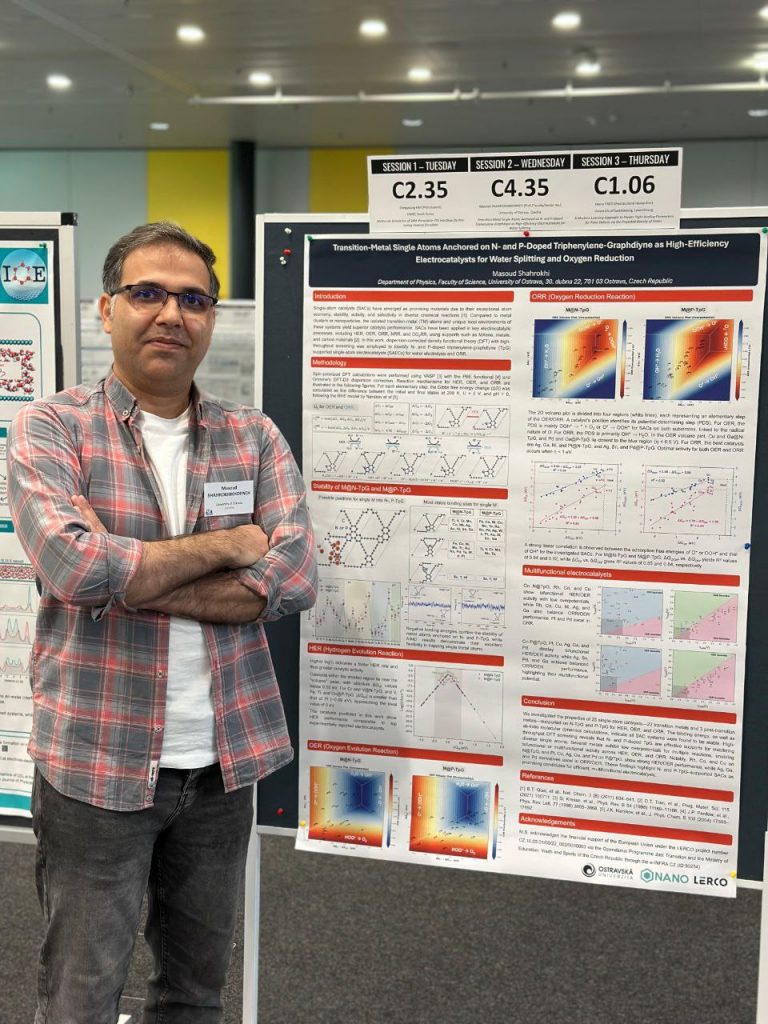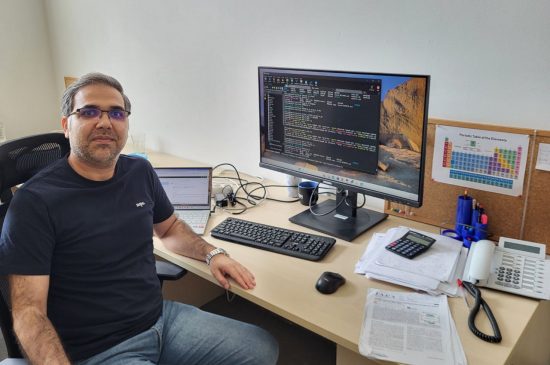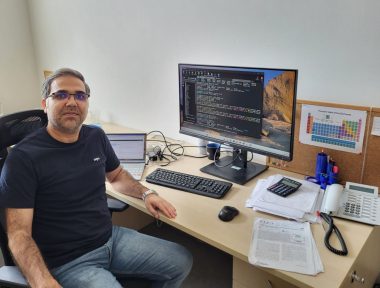Calculations and simulations are now underway to ensure that efforts toward ecological behaviour, with regard to future generations, will no longer go hand in hand with higher financial costs. Masoud Shahrokhikhorneh, a researcher at the University of Ostrava, is beginning to build a team of scientists focused on transforming nanostructures with an eye toward the energy of the future.
At first glance, this may seem like purely theoretical research modelling atomic behaviour, performing quantum-mechanical calculations, and simulating periodic materials. Yet this work could have very practical applications in the future. Physicist Masoud Shahrokhikhorneh, who joined the LERCO project in January this year as a key researcher, is a member of the Nanostructure Physics Group led by Dr. František Karlický. His work focuses on designing a new generation of catalysts that can significantly improve the efficiency of renewable energy production.
His main interest lies in so-called single-atom catalysts (SACs) and subnanoclusters -extremely small structures in which every atom has a specific place and function. This precise atomic architecture gives these materials unique electronic properties and high surface activity: “I see enormous potential for practical applications in this research. For example, in splitting water into hydrogen and oxygen, converting carbon dioxide into fuels, or producing ammonia in an environmentally friendly way,” notes Shahrokhikhorneh.
When will we use these elements?
Iron, cobalt, nickel – used in steel, magnets, and especially in batteries (e.g., in electric cars). If scientists can use them more efficiently, it could mean cheaper and longer-lasting batteries.
Platinum – currently a key element in car catalytic converters (cleaning exhaust gases) and fuel cells. Because it is very expensive, finding ways to use smaller amounts would mean substantial savings.
Tin – found in solder, packaging, and electronics. Research shows that when combined with precious metals (such as platinum), it can stabilize them and enhance their performance, leading to further savings.
Thanks to so-called first-principles modelling, it is possible to predict how atoms behave within a material, how charge transfer occurs between them, and which sites are active for chemical reactions. This precise understanding allows scientists to design “tailor-made” materials that are as efficient, stable, and affordable as possible: “I work closely with experimental groups abroad, where we link my theoretical models with practical laboratory testing to identify and verify the most promising catalyst candidates. This integrated approach can lead to the development of cost-effective, scalable catalysts that significantly improve the performance of electrolyzers, fuel cells, CO₂ converters, and other green energy systems,” concludes Dr. Shahrokhikhorneh.
Ultimately, the results of this research could help reduce dependence on critical raw materials, lower energy costs, and accelerate the adoption of clean technologies in industry, environmental protection, and energy production. This promises a positive ecological as well as financial impact on everyday life.

Dr. Masoud Shahrokhikhorneh specializes in electronic structure, catalysis, and nanomaterial modelling. He is the author of 75 scientific publications and serves as a reviewer for several international journals. Between 2021 and 2024, he was ranked among the world’s top 2% most cited scientists (Elsevier Data Repository). First time he learned about the group of scientists at the Faculty of Science, University of Ostrava, where he is now conducting groundbreaking research as part of the LERCO project, was during his postdoctoral stay at Université Paris-Est, where he studied the optical properties of 2D materials: “Since then, I have closely followed their publications, which consistently impressed me with their innovative approaches to nanomaterials and catalysis. Over the time, this scientific alignment developed into collaboration and ultimately inspired me to join them actively and contribute to advancing cutting-edge materials research.”
Life Environment Research Center Ostrava (LERCO) is a newly established scientific and research hub that serves as one of the key instruments enabling the transformation of the Moravian-Silesian Region (MSR) from a “coal-based” to a “healthier and smarter” region. With state-of-the-art facilities and nine excellent research teams, the project supports a wide and unique interdisciplinary focus across biomedical, natural, and behavioral sciences – ranging from basic research and experimental development to applied research – in collaboration with scientific and research institutions (University of Ostrava, University Hospital Ostrava, VSB–Technical University of Ostrava) and other national and international academic and commercial partners.
The project’s goal is to comprehensively support the development of the innovative research potential of the Moravian-Silesian Region in non-technical disciplines, with impacts on: public health, strengthening cooperation between science, research, and the commercial sector (including support for the creation of spin-off and start-up companies), promoting regional employment, increasing the region’s attractiveness in science, research, education, and for municipalities through the provision of innovative tools. The project is not based on commercial activities or their direct support; rather, in the long term, it aims to create a suitable foundation for future (and desirable) collaboration between the research and application spheres in the region – a connection that has so far been insufficiently developed.


 4 min.
4 min. 


